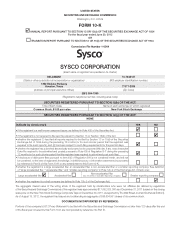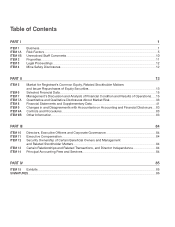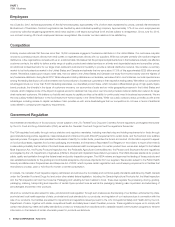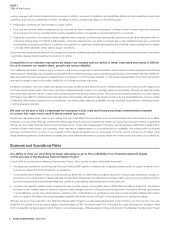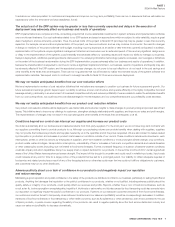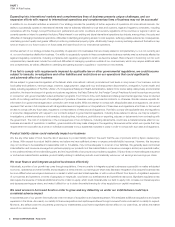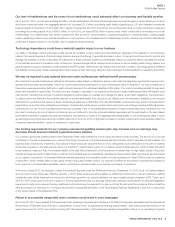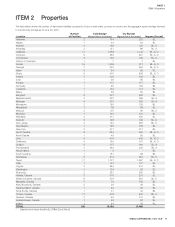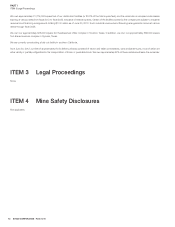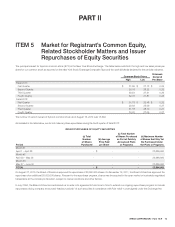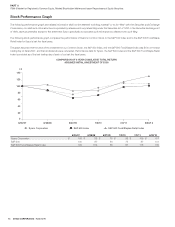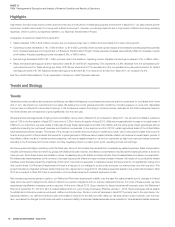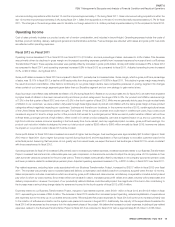Sysco 2012 Annual Report Download - page 32
Download and view the complete annual report
Please find page 32 of the 2012 Sysco annual report below. You can navigate through the pages in the report by either clicking on the pages listed below, or by using the keyword search tool below to find specific information within the annual report.SYSCO CORPORATION-Form10-K 9
PARTI
ITEM1ARisk Factors
Our level of indebtedness and the terms of our indebtedness could adversely affect our business and liquidity position
As of June30,2012, we had approximately $3billion of total indebtedness. We have a Board-approved commercial paper program allowing us to issue
short-term unsecured notes in an aggregate amount not to exceed $1.3billion; a revolving credit facility supporting our U.S.and Canadian commercial
paper programs in the amount of $1.0billion set to expire on December29,2016; and certain uncommitted bank lines of credit providing for unsecured
borrowings for working capital of up to $95.0million. In June2012, we issued $750million in senior notes, which contributed to an increase in our total
indebtedness. Our indebtedness may further increase from time to time for various reasons, including fl uctuations in operating results, working capital
needs, capital expenditures and potential acquisitions or joint ventures. Our increased level of indebtedness and the ultimate cost of such indebtedness
could have a negative impact on our liquidity, cost of capital and fi nancial results.
Technology dependence could have a material negative impact on our business
Our ability to decrease costs and increase profi ts, as well as our ability to serve customers most effectively, depends on the reliability of our technology
network. We use software and other technology systems, among other things, to generate and select orders, to load and route trucks and to monitor and
manage our business on a day-to-day basis. Any disruption to these computer systems could adversely impact our customer service, decrease the volume
of our business and result in increased costs. Furthermore, process changes will be required as we continue to use our existing warehousing, delivery, and
payroll systems to support operations as we implement the ERP system. While Sysco has invested and continues to invest in technology security initiatives
and disaster recovery plans, these measures cannot fully insulate us from technology disruption that could result in adverse effects on operations and profi ts.
We may be required to pay material amounts under multiemployer defi ned benefi t pension plans
We contribute to several multiemployer defi ned benefi t pension plans based on obligations arising under collective bargaining agreements covering union-
represented employees. Approximately 10% of our current employees are participants in such multiemployer plans. In fi scal 2012, our total contributions to
these plans were approximately $68million, which included payments for withdrawal liabilities of $34million. The costs of providing benefi ts through such
plans have increased in recent years. The amount of any increase or decrease in our required contributions to these multiemployer plans will depend upon
many factors, including the outcome of collective bargaining, actions taken by trustees who manage the plans, government regulations, the actual return
on assets held in the plans and the potential payment of a withdrawal liability if we choose to exit. Based upon the information available to us from plan
administrators, we believe that several of these multiemployer plans are underfunded. The unfunded liabilities of these plans may result in increased future
payments by us and the other participating employers. Underfunded multiemployer pension plans may impose a surcharge requiring additional pension
contributions. Our risk of such increased payments may be greater if any of the participating employers in these underfunded plans withdraws from the
plan due to insolvency and is not able to contribute an amount suffi cient to fund the unfunded liabilities associated with its participants in the plan. Based
on the latest information available from plan administrators, we estimate our share of the aggregate withdrawal liability on the multiemployer plans in which
we participate could have been as much as $205million as of June30,2012. A signifi cant increase to funding requirements could adversely affect the
Company’s fi nancial condition, results of operations or cash fl ows.
Our funding requirements for our company-sponsored qualifi ed pension plan may increase and our earnings may
decrease should fi nancial markets experience future declines
Our company-sponsored qualifi ed pension plan (Retirement Plan) holds investments in both equity and fi xed income securities. The amount of our annual
contribution to the plan is dependent upon, among other things, the returns on the plan’s assets and discount rates used to calculate the plan’s liability. Our
expense is also impacted by these items. Fluctuations in asset values can cause the amount of our anticipated future contributions to the plan to increase
and pension expense to increase and can result in a reduction to shareholders’ equity on our balance sheet at fi scal year-end, which is when this plan’s
funded status is measured. Also, the projected liability of the plan will be impacted by the fl uctuations of interest rates on high quality bonds in the public
markets as these are inputs in determining our discount rate at fi scal year-end. Specifi cally, decreases in these interest rates may have an adverse impact
on our results of operations. To the extent fi nancial markets experience future declines similar to those experienced in fi scal 2008 through the beginning
of fi scal 2010, and/or interest rates on high quality bonds in the public markets decline, our required contributions and pension expense may increase for
future years as our funded status decreases, which could have an adverse impact on our liquidity and results of operations.
At the end of fi scal 2012, we decided to freeze future benefi t accruals under the Retirement Plan as of December31,2012 for all U.S.-based salaried
and non-union hourly employees. Effective January1,2013, these employees will be eligible for additional contributions under an enhanced, defi ned
contribution plan. While these actions will serve to limit future growth in our pension liabilities, we had a sizable pension obligation of $2.7billion as of
June30,2012 which could continue to impact our funding requirements and our earnings. Additionally, although recent pension funding relief legislation
has served to defer some required funding, additional contributions may be required if our plan is not fully funded when the provisions that provided the
relief are phased out. See Note13, “Company-Sponsored Employee Benefi t Plans” to the Consolidated Financial Statements in Item8 for a discussion
of the funded status of the Retirement Plan.
Failure to successfully renegotiate union contracts could result in work stoppages
As of June30,2012, approximately 8,200employees at 50operating companies were members of 53different local unions associated with the International
Brotherhood of Teamsters and other labor organizations. In fi scal 2013, 15agreements covering approximately 1,400employees have expired or will
expire. Since June30,2012, one contract covering 48 of the approximately 1,400employees has been renegotiated. Failure of our operating companies


